BA7564 - Repsol's YPF Takeover: Strategic and Financial Analysis
VerifiedAdded on 2023/06/15
|16
|4441
|185
Case Study
AI Summary
This case study provides an analysis of Repsol's takeover bid for YPF, examining the strategic positions of both companies before the acquisition, their alternative strategic options, and the rationale behind the merger. It assesses the standalone value of YPF and its potential value under Repsol's ownership, determining a reasonable acquisition price and the optimal payment method. The analysis includes a calculation of free cash flow and weighted average cost of capital (WACC) to evaluate the financial implications of the merger. Furthermore, the study identifies key factors that could affect the success of the acquisition, considering both the opportunities and threats associated with the proposed deal. This document is available on Desklib, a platform offering a wide range of study resources, including past papers and solved assignments, to support students in their academic endeavors.

Paraphrase This Document
Need a fresh take? Get an instant paraphrase of this document with our AI Paraphraser
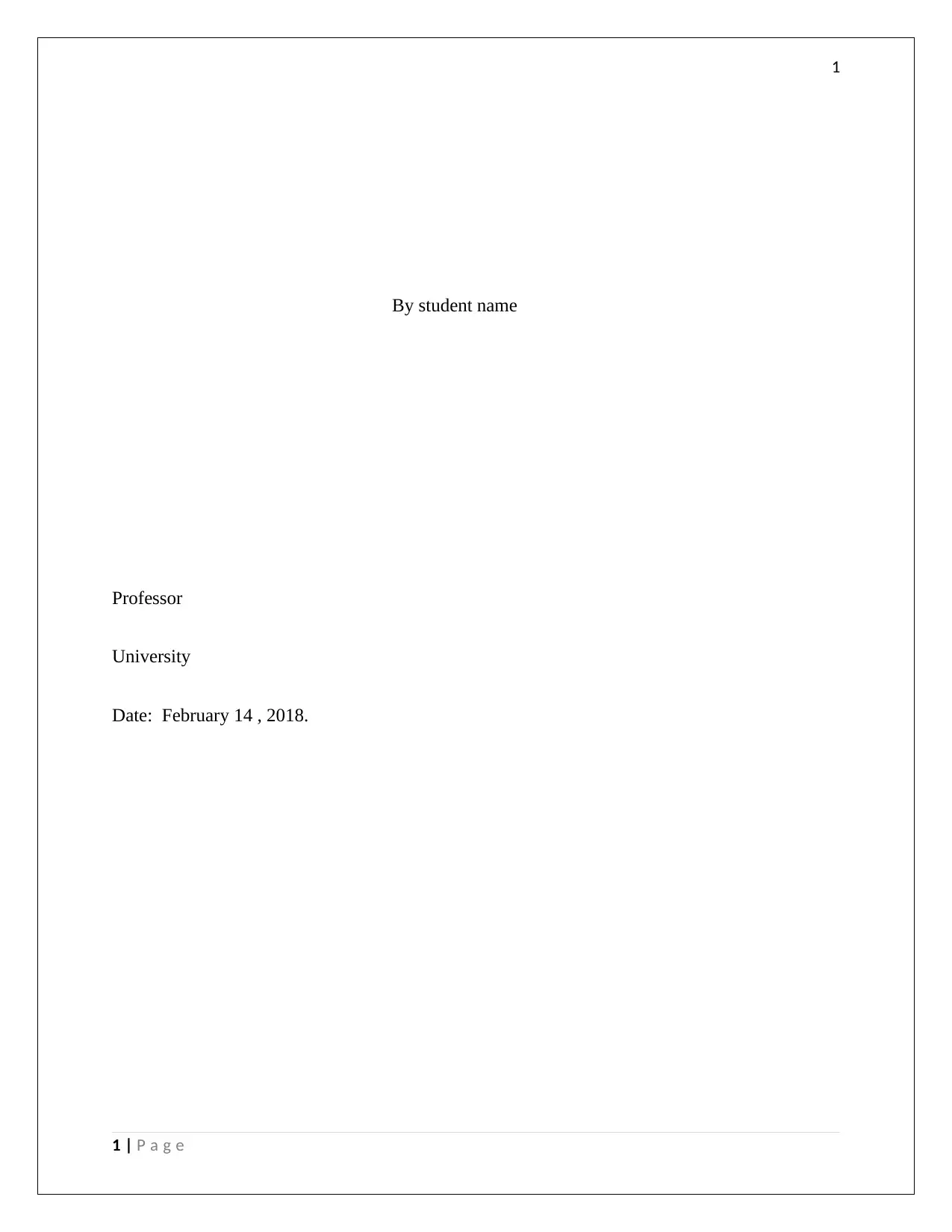
1
By student name
Professor
University
Date: February 14 , 2018.
1 | P a g e
By student name
Professor
University
Date: February 14 , 2018.
1 | P a g e
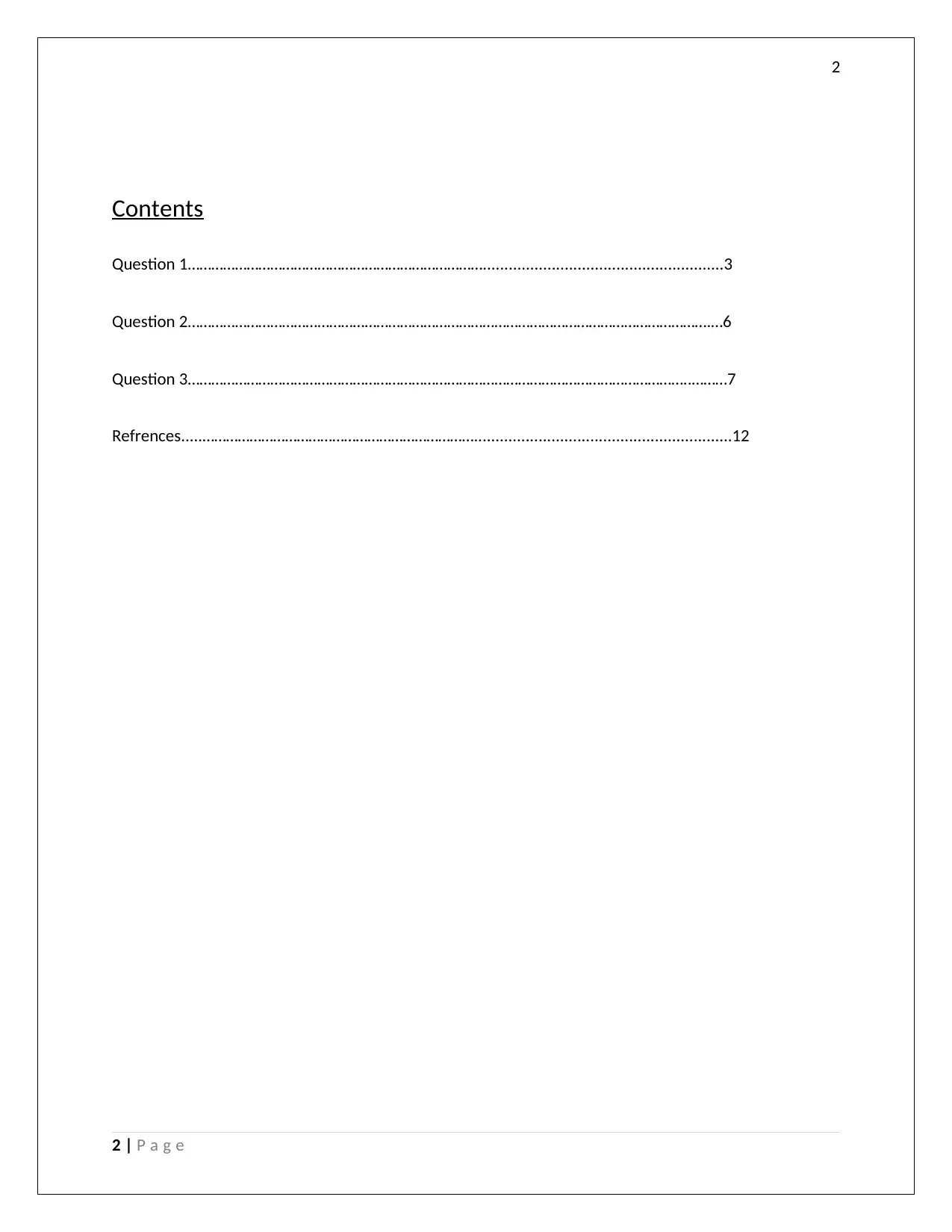
2
Contents
Question 1…………………………………………………………………........................................................3
Question 2…………………………………………………………………………………………………………………….…6
Question 3………………………………………………………………………………………………………………..………7
Refrences.....……………………………………………………………............................................................12
2 | P a g e
Contents
Question 1…………………………………………………………………........................................................3
Question 2…………………………………………………………………………………………………………………….…6
Question 3………………………………………………………………………………………………………………..………7
Refrences.....……………………………………………………………............................................................12
2 | P a g e
You're viewing a preview
Unlock full access by subscribing today!
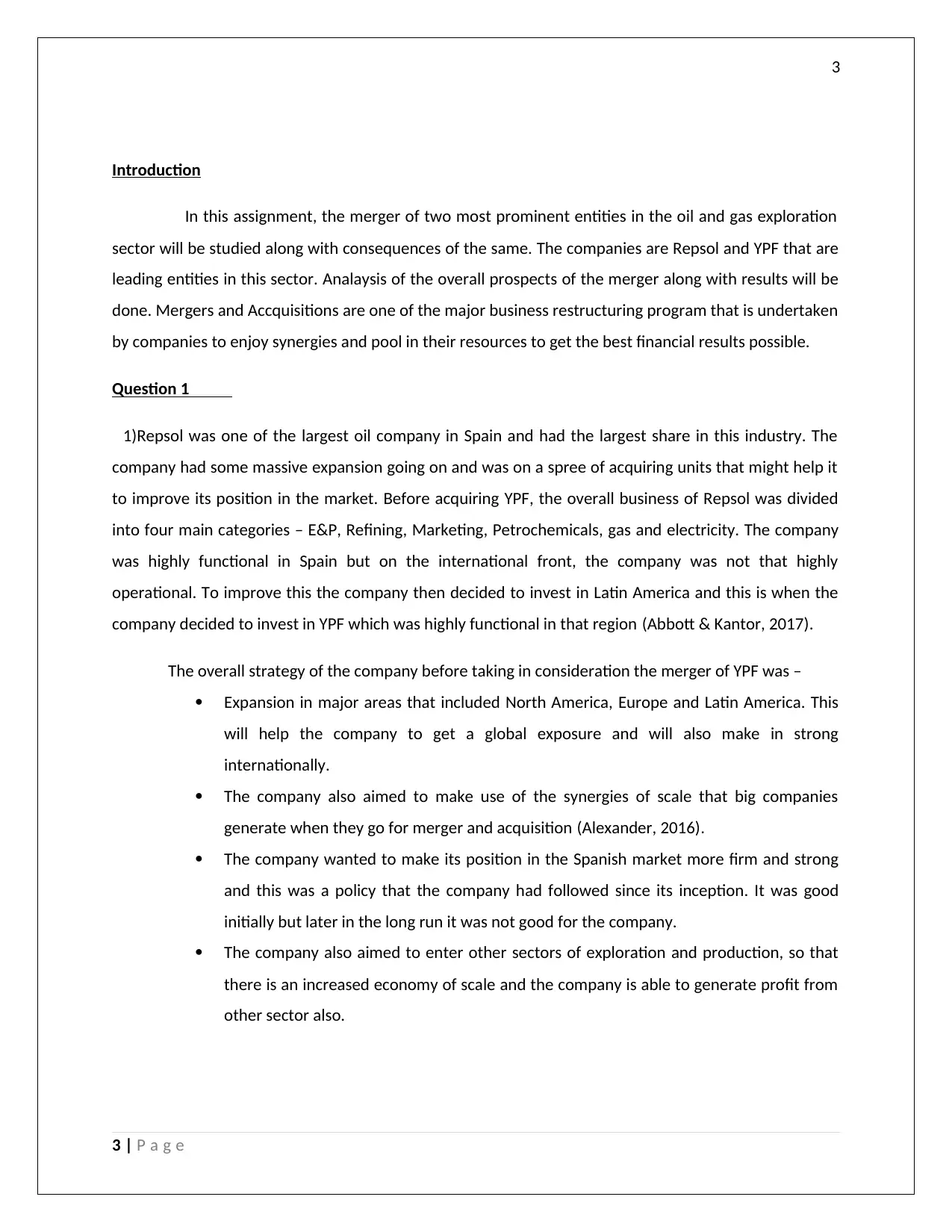
3
Introduction
In this assignment, the merger of two most prominent entities in the oil and gas exploration
sector will be studied along with consequences of the same. The companies are Repsol and YPF that are
leading entities in this sector. Analaysis of the overall prospects of the merger along with results will be
done. Mergers and Accquisitions are one of the major business restructuring program that is undertaken
by companies to enjoy synergies and pool in their resources to get the best financial results possible.
Question 1
1)Repsol was one of the largest oil company in Spain and had the largest share in this industry. The
company had some massive expansion going on and was on a spree of acquiring units that might help it
to improve its position in the market. Before acquiring YPF, the overall business of Repsol was divided
into four main categories – E&P, Refining, Marketing, Petrochemicals, gas and electricity. The company
was highly functional in Spain but on the international front, the company was not that highly
operational. To improve this the company then decided to invest in Latin America and this is when the
company decided to invest in YPF which was highly functional in that region (Abbott & Kantor, 2017).
The overall strategy of the company before taking in consideration the merger of YPF was –
Expansion in major areas that included North America, Europe and Latin America. This
will help the company to get a global exposure and will also make in strong
internationally.
The company also aimed to make use of the synergies of scale that big companies
generate when they go for merger and acquisition (Alexander, 2016).
The company wanted to make its position in the Spanish market more firm and strong
and this was a policy that the company had followed since its inception. It was good
initially but later in the long run it was not good for the company.
The company also aimed to enter other sectors of exploration and production, so that
there is an increased economy of scale and the company is able to generate profit from
other sector also.
3 | P a g e
Introduction
In this assignment, the merger of two most prominent entities in the oil and gas exploration
sector will be studied along with consequences of the same. The companies are Repsol and YPF that are
leading entities in this sector. Analaysis of the overall prospects of the merger along with results will be
done. Mergers and Accquisitions are one of the major business restructuring program that is undertaken
by companies to enjoy synergies and pool in their resources to get the best financial results possible.
Question 1
1)Repsol was one of the largest oil company in Spain and had the largest share in this industry. The
company had some massive expansion going on and was on a spree of acquiring units that might help it
to improve its position in the market. Before acquiring YPF, the overall business of Repsol was divided
into four main categories – E&P, Refining, Marketing, Petrochemicals, gas and electricity. The company
was highly functional in Spain but on the international front, the company was not that highly
operational. To improve this the company then decided to invest in Latin America and this is when the
company decided to invest in YPF which was highly functional in that region (Abbott & Kantor, 2017).
The overall strategy of the company before taking in consideration the merger of YPF was –
Expansion in major areas that included North America, Europe and Latin America. This
will help the company to get a global exposure and will also make in strong
internationally.
The company also aimed to make use of the synergies of scale that big companies
generate when they go for merger and acquisition (Alexander, 2016).
The company wanted to make its position in the Spanish market more firm and strong
and this was a policy that the company had followed since its inception. It was good
initially but later in the long run it was not good for the company.
The company also aimed to enter other sectors of exploration and production, so that
there is an increased economy of scale and the company is able to generate profit from
other sector also.
3 | P a g e
Paraphrase This Document
Need a fresh take? Get an instant paraphrase of this document with our AI Paraphraser
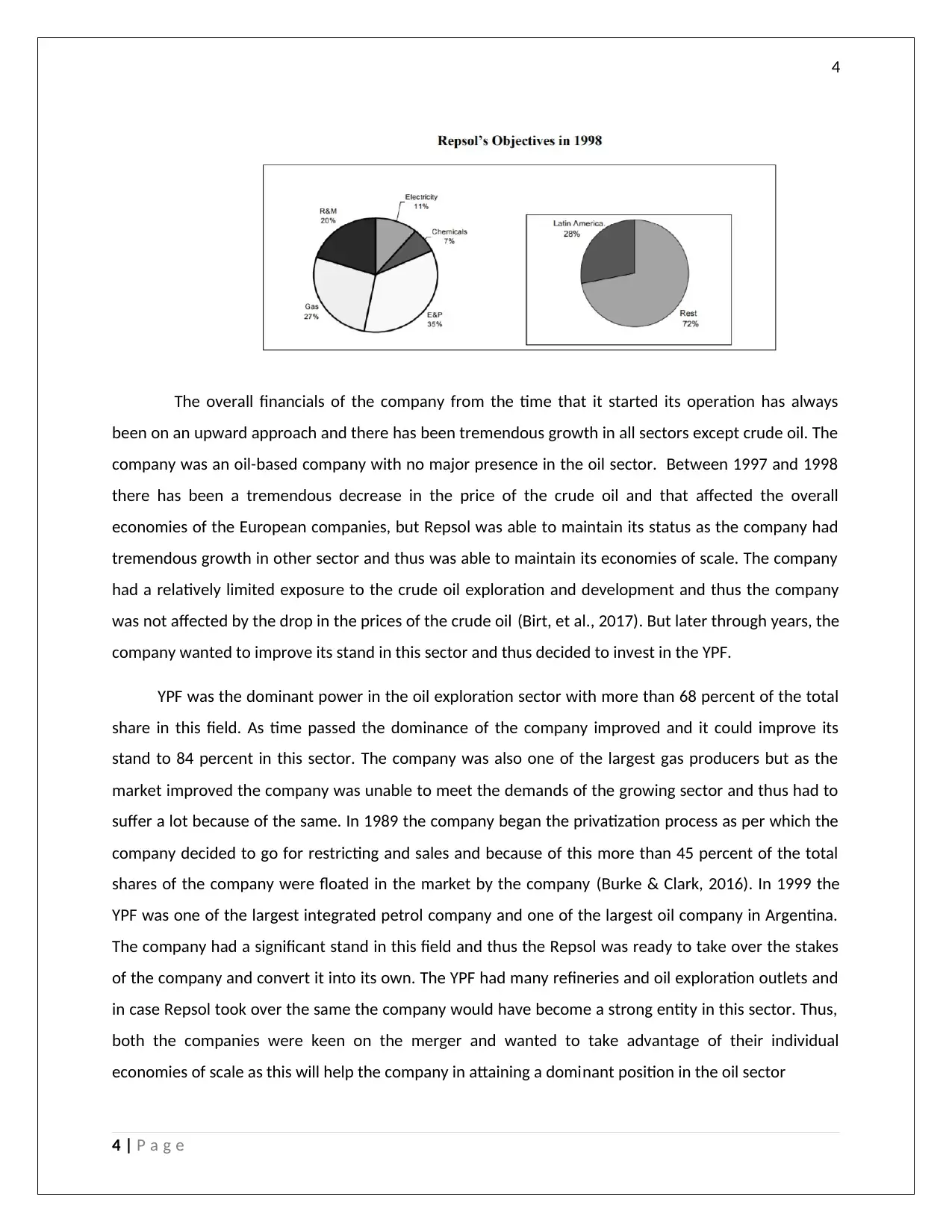
4
The overall financials of the company from the time that it started its operation has always
been on an upward approach and there has been tremendous growth in all sectors except crude oil. The
company was an oil-based company with no major presence in the oil sector. Between 1997 and 1998
there has been a tremendous decrease in the price of the crude oil and that affected the overall
economies of the European companies, but Repsol was able to maintain its status as the company had
tremendous growth in other sector and thus was able to maintain its economies of scale. The company
had a relatively limited exposure to the crude oil exploration and development and thus the company
was not affected by the drop in the prices of the crude oil (Birt, et al., 2017). But later through years, the
company wanted to improve its stand in this sector and thus decided to invest in the YPF.
YPF was the dominant power in the oil exploration sector with more than 68 percent of the total
share in this field. As time passed the dominance of the company improved and it could improve its
stand to 84 percent in this sector. The company was also one of the largest gas producers but as the
market improved the company was unable to meet the demands of the growing sector and thus had to
suffer a lot because of the same. In 1989 the company began the privatization process as per which the
company decided to go for restricting and sales and because of this more than 45 percent of the total
shares of the company were floated in the market by the company (Burke & Clark, 2016). In 1999 the
YPF was one of the largest integrated petrol company and one of the largest oil company in Argentina.
The company had a significant stand in this field and thus the Repsol was ready to take over the stakes
of the company and convert it into its own. The YPF had many refineries and oil exploration outlets and
in case Repsol took over the same the company would have become a strong entity in this sector. Thus,
both the companies were keen on the merger and wanted to take advantage of their individual
economies of scale as this will help the company in attaining a dominant position in the oil sector
4 | P a g e
The overall financials of the company from the time that it started its operation has always
been on an upward approach and there has been tremendous growth in all sectors except crude oil. The
company was an oil-based company with no major presence in the oil sector. Between 1997 and 1998
there has been a tremendous decrease in the price of the crude oil and that affected the overall
economies of the European companies, but Repsol was able to maintain its status as the company had
tremendous growth in other sector and thus was able to maintain its economies of scale. The company
had a relatively limited exposure to the crude oil exploration and development and thus the company
was not affected by the drop in the prices of the crude oil (Birt, et al., 2017). But later through years, the
company wanted to improve its stand in this sector and thus decided to invest in the YPF.
YPF was the dominant power in the oil exploration sector with more than 68 percent of the total
share in this field. As time passed the dominance of the company improved and it could improve its
stand to 84 percent in this sector. The company was also one of the largest gas producers but as the
market improved the company was unable to meet the demands of the growing sector and thus had to
suffer a lot because of the same. In 1989 the company began the privatization process as per which the
company decided to go for restricting and sales and because of this more than 45 percent of the total
shares of the company were floated in the market by the company (Burke & Clark, 2016). In 1999 the
YPF was one of the largest integrated petrol company and one of the largest oil company in Argentina.
The company had a significant stand in this field and thus the Repsol was ready to take over the stakes
of the company and convert it into its own. The YPF had many refineries and oil exploration outlets and
in case Repsol took over the same the company would have become a strong entity in this sector. Thus,
both the companies were keen on the merger and wanted to take advantage of their individual
economies of scale as this will help the company in attaining a dominant position in the oil sector
4 | P a g e
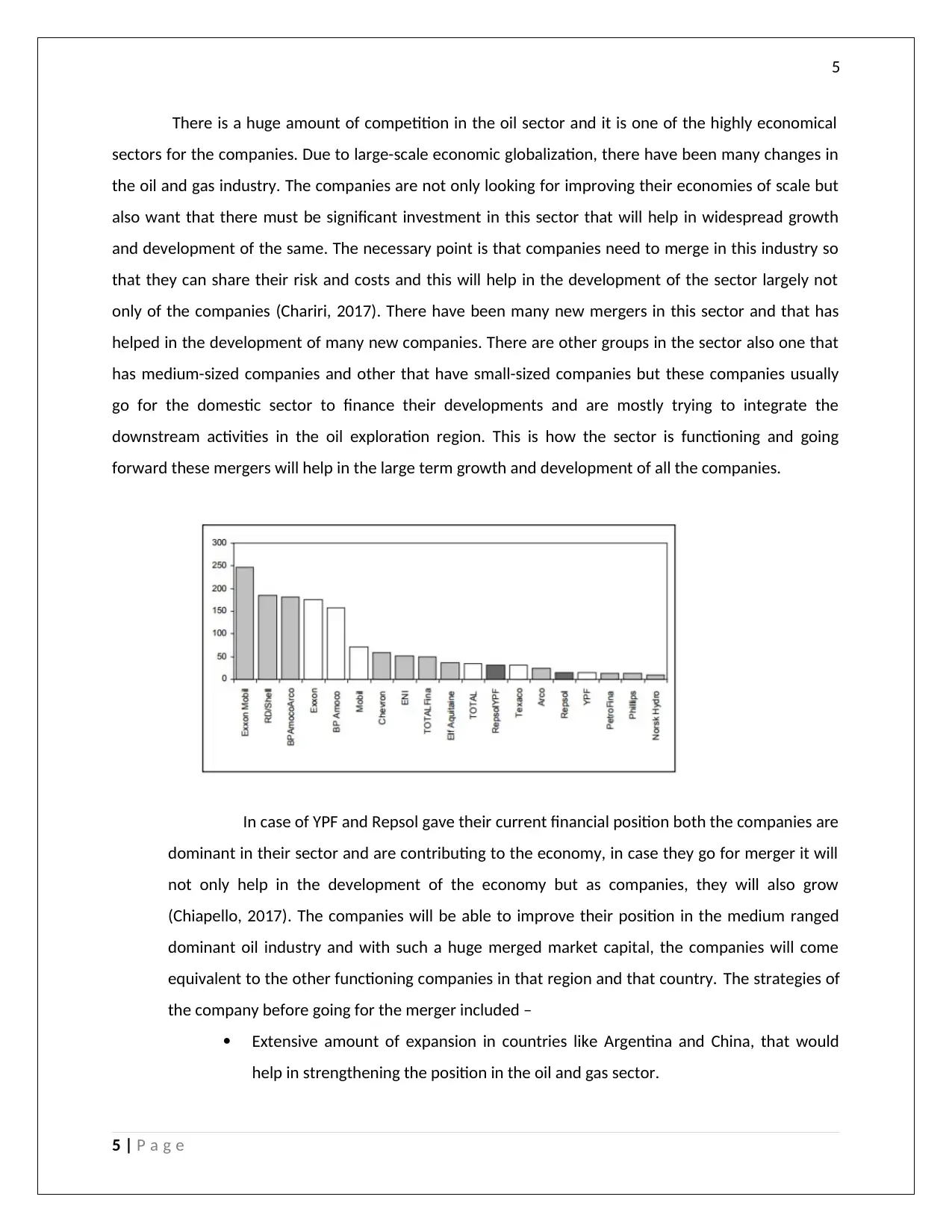
5
There is a huge amount of competition in the oil sector and it is one of the highly economical
sectors for the companies. Due to large-scale economic globalization, there have been many changes in
the oil and gas industry. The companies are not only looking for improving their economies of scale but
also want that there must be significant investment in this sector that will help in widespread growth
and development of the same. The necessary point is that companies need to merge in this industry so
that they can share their risk and costs and this will help in the development of the sector largely not
only of the companies (Chariri, 2017). There have been many new mergers in this sector and that has
helped in the development of many new companies. There are other groups in the sector also one that
has medium-sized companies and other that have small-sized companies but these companies usually
go for the domestic sector to finance their developments and are mostly trying to integrate the
downstream activities in the oil exploration region. This is how the sector is functioning and going
forward these mergers will help in the large term growth and development of all the companies.
In case of YPF and Repsol gave their current financial position both the companies are
dominant in their sector and are contributing to the economy, in case they go for merger it will
not only help in the development of the economy but as companies, they will also grow
(Chiapello, 2017). The companies will be able to improve their position in the medium ranged
dominant oil industry and with such a huge merged market capital, the companies will come
equivalent to the other functioning companies in that region and that country. The strategies of
the company before going for the merger included –
Extensive amount of expansion in countries like Argentina and China, that would
help in strengthening the position in the oil and gas sector.
5 | P a g e
There is a huge amount of competition in the oil sector and it is one of the highly economical
sectors for the companies. Due to large-scale economic globalization, there have been many changes in
the oil and gas industry. The companies are not only looking for improving their economies of scale but
also want that there must be significant investment in this sector that will help in widespread growth
and development of the same. The necessary point is that companies need to merge in this industry so
that they can share their risk and costs and this will help in the development of the sector largely not
only of the companies (Chariri, 2017). There have been many new mergers in this sector and that has
helped in the development of many new companies. There are other groups in the sector also one that
has medium-sized companies and other that have small-sized companies but these companies usually
go for the domestic sector to finance their developments and are mostly trying to integrate the
downstream activities in the oil exploration region. This is how the sector is functioning and going
forward these mergers will help in the large term growth and development of all the companies.
In case of YPF and Repsol gave their current financial position both the companies are
dominant in their sector and are contributing to the economy, in case they go for merger it will
not only help in the development of the economy but as companies, they will also grow
(Chiapello, 2017). The companies will be able to improve their position in the medium ranged
dominant oil industry and with such a huge merged market capital, the companies will come
equivalent to the other functioning companies in that region and that country. The strategies of
the company before going for the merger included –
Extensive amount of expansion in countries like Argentina and China, that would
help in strengthening the position in the oil and gas sector.
5 | P a g e
You're viewing a preview
Unlock full access by subscribing today!
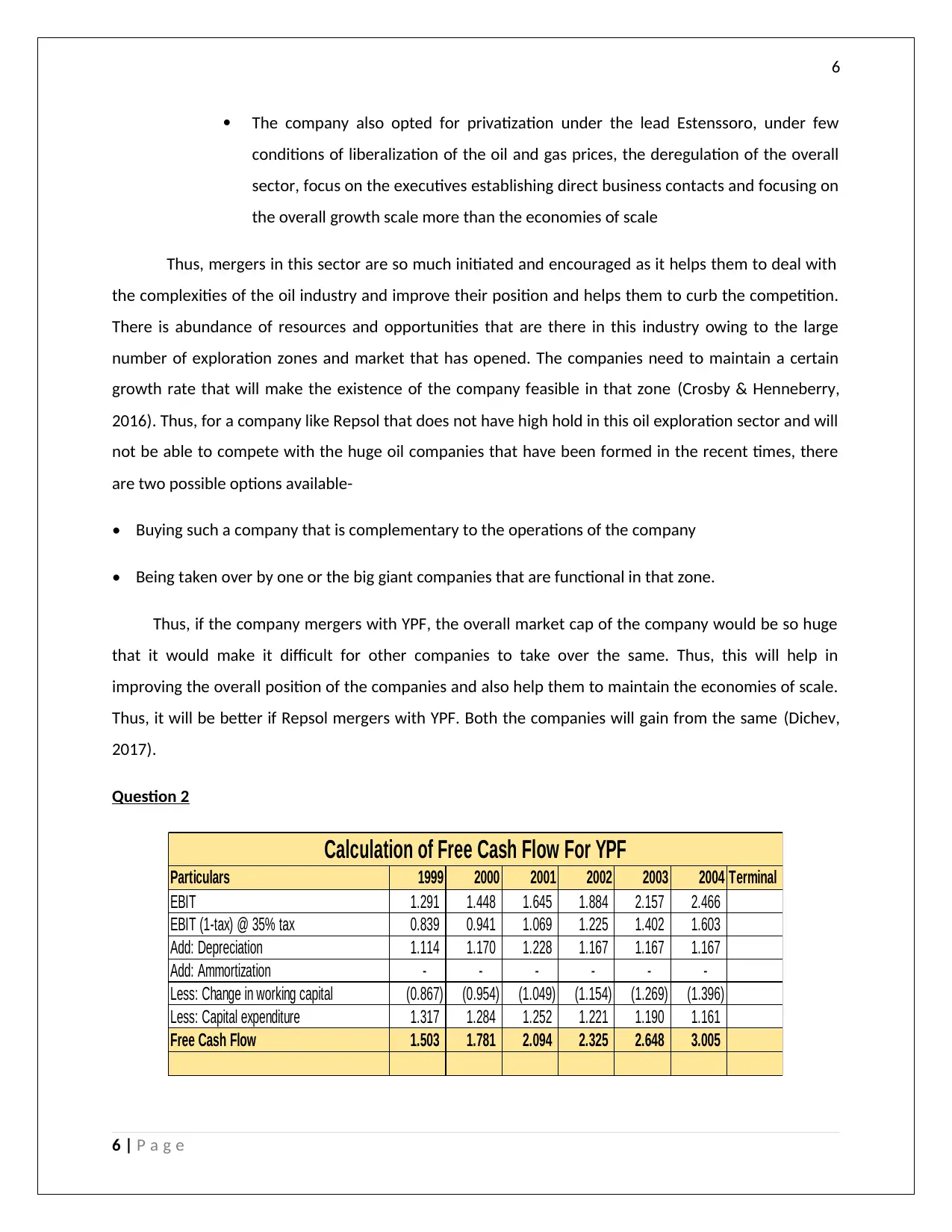
6
The company also opted for privatization under the lead Estenssoro, under few
conditions of liberalization of the oil and gas prices, the deregulation of the overall
sector, focus on the executives establishing direct business contacts and focusing on
the overall growth scale more than the economies of scale
Thus, mergers in this sector are so much initiated and encouraged as it helps them to deal with
the complexities of the oil industry and improve their position and helps them to curb the competition.
There is abundance of resources and opportunities that are there in this industry owing to the large
number of exploration zones and market that has opened. The companies need to maintain a certain
growth rate that will make the existence of the company feasible in that zone (Crosby & Henneberry,
2016). Thus, for a company like Repsol that does not have high hold in this oil exploration sector and will
not be able to compete with the huge oil companies that have been formed in the recent times, there
are two possible options available-
• Buying such a company that is complementary to the operations of the company
• Being taken over by one or the big giant companies that are functional in that zone.
Thus, if the company mergers with YPF, the overall market cap of the company would be so huge
that it would make it difficult for other companies to take over the same. Thus, this will help in
improving the overall position of the companies and also help them to maintain the economies of scale.
Thus, it will be better if Repsol mergers with YPF. Both the companies will gain from the same (Dichev,
2017).
Question 2
Particulars 1999 2000 2001 2002 2003 2004 Terminal
EBIT 1.291 1.448 1.645 1.884 2.157 2.466
EBIT (1-tax) @ 35% tax 0.839 0.941 1.069 1.225 1.402 1.603
Add: Depreciation 1.114 1.170 1.228 1.167 1.167 1.167
Add: Ammortization - - - - - -
Less: Change in working capital (0.867) (0.954) (1.049) (1.154) (1.269) (1.396)
Less: Capital expenditure 1.317 1.284 1.252 1.221 1.190 1.161
Free Cash Flow 1.503 1.781 2.094 2.325 2.648 3.005
Calculation of Free Cash Flow For YPF
6 | P a g e
The company also opted for privatization under the lead Estenssoro, under few
conditions of liberalization of the oil and gas prices, the deregulation of the overall
sector, focus on the executives establishing direct business contacts and focusing on
the overall growth scale more than the economies of scale
Thus, mergers in this sector are so much initiated and encouraged as it helps them to deal with
the complexities of the oil industry and improve their position and helps them to curb the competition.
There is abundance of resources and opportunities that are there in this industry owing to the large
number of exploration zones and market that has opened. The companies need to maintain a certain
growth rate that will make the existence of the company feasible in that zone (Crosby & Henneberry,
2016). Thus, for a company like Repsol that does not have high hold in this oil exploration sector and will
not be able to compete with the huge oil companies that have been formed in the recent times, there
are two possible options available-
• Buying such a company that is complementary to the operations of the company
• Being taken over by one or the big giant companies that are functional in that zone.
Thus, if the company mergers with YPF, the overall market cap of the company would be so huge
that it would make it difficult for other companies to take over the same. Thus, this will help in
improving the overall position of the companies and also help them to maintain the economies of scale.
Thus, it will be better if Repsol mergers with YPF. Both the companies will gain from the same (Dichev,
2017).
Question 2
Particulars 1999 2000 2001 2002 2003 2004 Terminal
EBIT 1.291 1.448 1.645 1.884 2.157 2.466
EBIT (1-tax) @ 35% tax 0.839 0.941 1.069 1.225 1.402 1.603
Add: Depreciation 1.114 1.170 1.228 1.167 1.167 1.167
Add: Ammortization - - - - - -
Less: Change in working capital (0.867) (0.954) (1.049) (1.154) (1.269) (1.396)
Less: Capital expenditure 1.317 1.284 1.252 1.221 1.190 1.161
Free Cash Flow 1.503 1.781 2.094 2.325 2.648 3.005
Calculation of Free Cash Flow For YPF
6 | P a g e
Paraphrase This Document
Need a fresh take? Get an instant paraphrase of this document with our AI Paraphraser
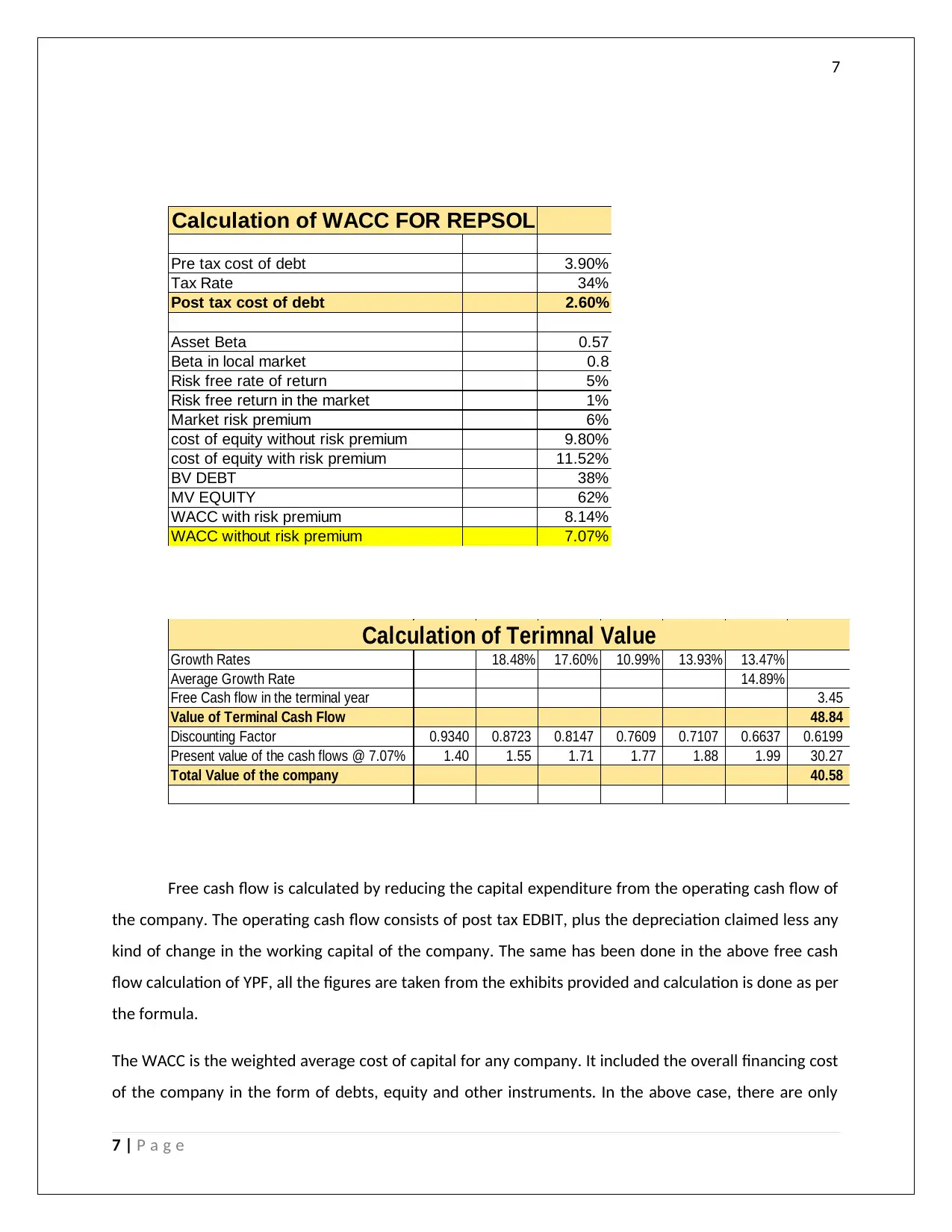
7
Calculation of WACC FOR REPSOL
Pre tax cost of debt 3.90%
Tax Rate 34%
Post tax cost of debt 2.60%
Asset Beta 0.57
Beta in local market 0.8
Risk free rate of return 5%
Risk free return in the market 1%
Market risk premium 6%
cost of equity without risk premium 9.80%
cost of equity with risk premium 11.52%
BV DEBT 38%
MV EQUITY 62%
WACC with risk premium 8.14%
WACC without risk premium 7.07%
Growth Rates 18.48% 17.60% 10.99% 13.93% 13.47%
Average Growth Rate 14.89%
Free Cash flow in the terminal year 3.45
Value of Terminal Cash Flow 48.84
Discounting Factor 0.9340 0.8723 0.8147 0.7609 0.7107 0.6637 0.6199
Present value of the cash flows @ 7.07% 1.40 1.55 1.71 1.77 1.88 1.99 30.27
Total Value of the company 40.58
Calculation of Terimnal Value
Free cash flow is calculated by reducing the capital expenditure from the operating cash flow of
the company. The operating cash flow consists of post tax EDBIT, plus the depreciation claimed less any
kind of change in the working capital of the company. The same has been done in the above free cash
flow calculation of YPF, all the figures are taken from the exhibits provided and calculation is done as per
the formula.
The WACC is the weighted average cost of capital for any company. It included the overall financing cost
of the company in the form of debts, equity and other instruments. In the above case, there are only
7 | P a g e
Calculation of WACC FOR REPSOL
Pre tax cost of debt 3.90%
Tax Rate 34%
Post tax cost of debt 2.60%
Asset Beta 0.57
Beta in local market 0.8
Risk free rate of return 5%
Risk free return in the market 1%
Market risk premium 6%
cost of equity without risk premium 9.80%
cost of equity with risk premium 11.52%
BV DEBT 38%
MV EQUITY 62%
WACC with risk premium 8.14%
WACC without risk premium 7.07%
Growth Rates 18.48% 17.60% 10.99% 13.93% 13.47%
Average Growth Rate 14.89%
Free Cash flow in the terminal year 3.45
Value of Terminal Cash Flow 48.84
Discounting Factor 0.9340 0.8723 0.8147 0.7609 0.7107 0.6637 0.6199
Present value of the cash flows @ 7.07% 1.40 1.55 1.71 1.77 1.88 1.99 30.27
Total Value of the company 40.58
Calculation of Terimnal Value
Free cash flow is calculated by reducing the capital expenditure from the operating cash flow of
the company. The operating cash flow consists of post tax EDBIT, plus the depreciation claimed less any
kind of change in the working capital of the company. The same has been done in the above free cash
flow calculation of YPF, all the figures are taken from the exhibits provided and calculation is done as per
the formula.
The WACC is the weighted average cost of capital for any company. It included the overall financing cost
of the company in the form of debts, equity and other instruments. In the above case, there are only
7 | P a g e
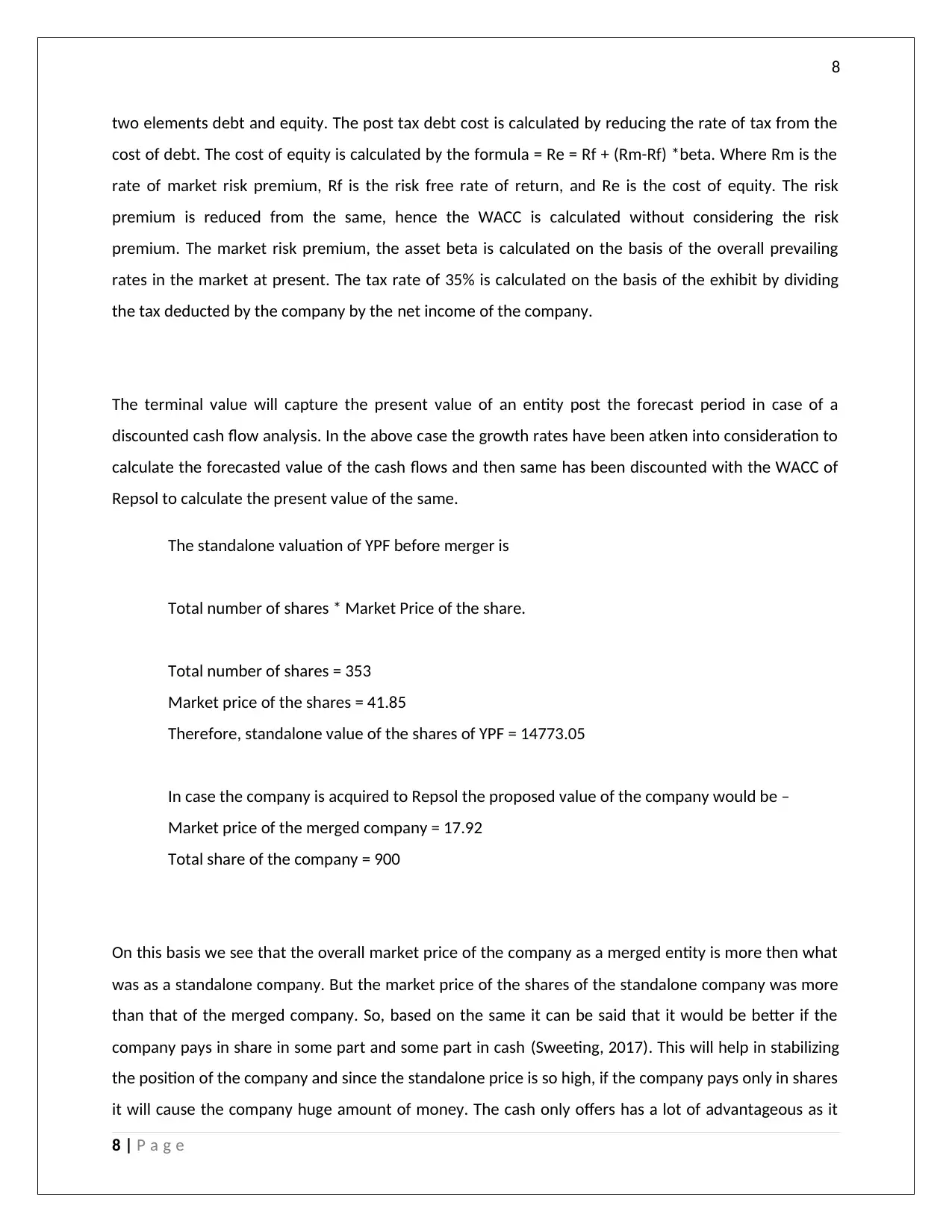
8
two elements debt and equity. The post tax debt cost is calculated by reducing the rate of tax from the
cost of debt. The cost of equity is calculated by the formula = Re = Rf + (Rm-Rf) *beta. Where Rm is the
rate of market risk premium, Rf is the risk free rate of return, and Re is the cost of equity. The risk
premium is reduced from the same, hence the WACC is calculated without considering the risk
premium. The market risk premium, the asset beta is calculated on the basis of the overall prevailing
rates in the market at present. The tax rate of 35% is calculated on the basis of the exhibit by dividing
the tax deducted by the company by the net income of the company.
The terminal value will capture the present value of an entity post the forecast period in case of a
discounted cash flow analysis. In the above case the growth rates have been atken into consideration to
calculate the forecasted value of the cash flows and then same has been discounted with the WACC of
Repsol to calculate the present value of the same.
The standalone valuation of YPF before merger is
Total number of shares * Market Price of the share.
Total number of shares = 353
Market price of the shares = 41.85
Therefore, standalone value of the shares of YPF = 14773.05
In case the company is acquired to Repsol the proposed value of the company would be –
Market price of the merged company = 17.92
Total share of the company = 900
On this basis we see that the overall market price of the company as a merged entity is more then what
was as a standalone company. But the market price of the shares of the standalone company was more
than that of the merged company. So, based on the same it can be said that it would be better if the
company pays in share in some part and some part in cash (Sweeting, 2017). This will help in stabilizing
the position of the company and since the standalone price is so high, if the company pays only in shares
it will cause the company huge amount of money. The cash only offers has a lot of advantageous as it
8 | P a g e
two elements debt and equity. The post tax debt cost is calculated by reducing the rate of tax from the
cost of debt. The cost of equity is calculated by the formula = Re = Rf + (Rm-Rf) *beta. Where Rm is the
rate of market risk premium, Rf is the risk free rate of return, and Re is the cost of equity. The risk
premium is reduced from the same, hence the WACC is calculated without considering the risk
premium. The market risk premium, the asset beta is calculated on the basis of the overall prevailing
rates in the market at present. The tax rate of 35% is calculated on the basis of the exhibit by dividing
the tax deducted by the company by the net income of the company.
The terminal value will capture the present value of an entity post the forecast period in case of a
discounted cash flow analysis. In the above case the growth rates have been atken into consideration to
calculate the forecasted value of the cash flows and then same has been discounted with the WACC of
Repsol to calculate the present value of the same.
The standalone valuation of YPF before merger is
Total number of shares * Market Price of the share.
Total number of shares = 353
Market price of the shares = 41.85
Therefore, standalone value of the shares of YPF = 14773.05
In case the company is acquired to Repsol the proposed value of the company would be –
Market price of the merged company = 17.92
Total share of the company = 900
On this basis we see that the overall market price of the company as a merged entity is more then what
was as a standalone company. But the market price of the shares of the standalone company was more
than that of the merged company. So, based on the same it can be said that it would be better if the
company pays in share in some part and some part in cash (Sweeting, 2017). This will help in stabilizing
the position of the company and since the standalone price is so high, if the company pays only in shares
it will cause the company huge amount of money. The cash only offers has a lot of advantageous as it
8 | P a g e
You're viewing a preview
Unlock full access by subscribing today!
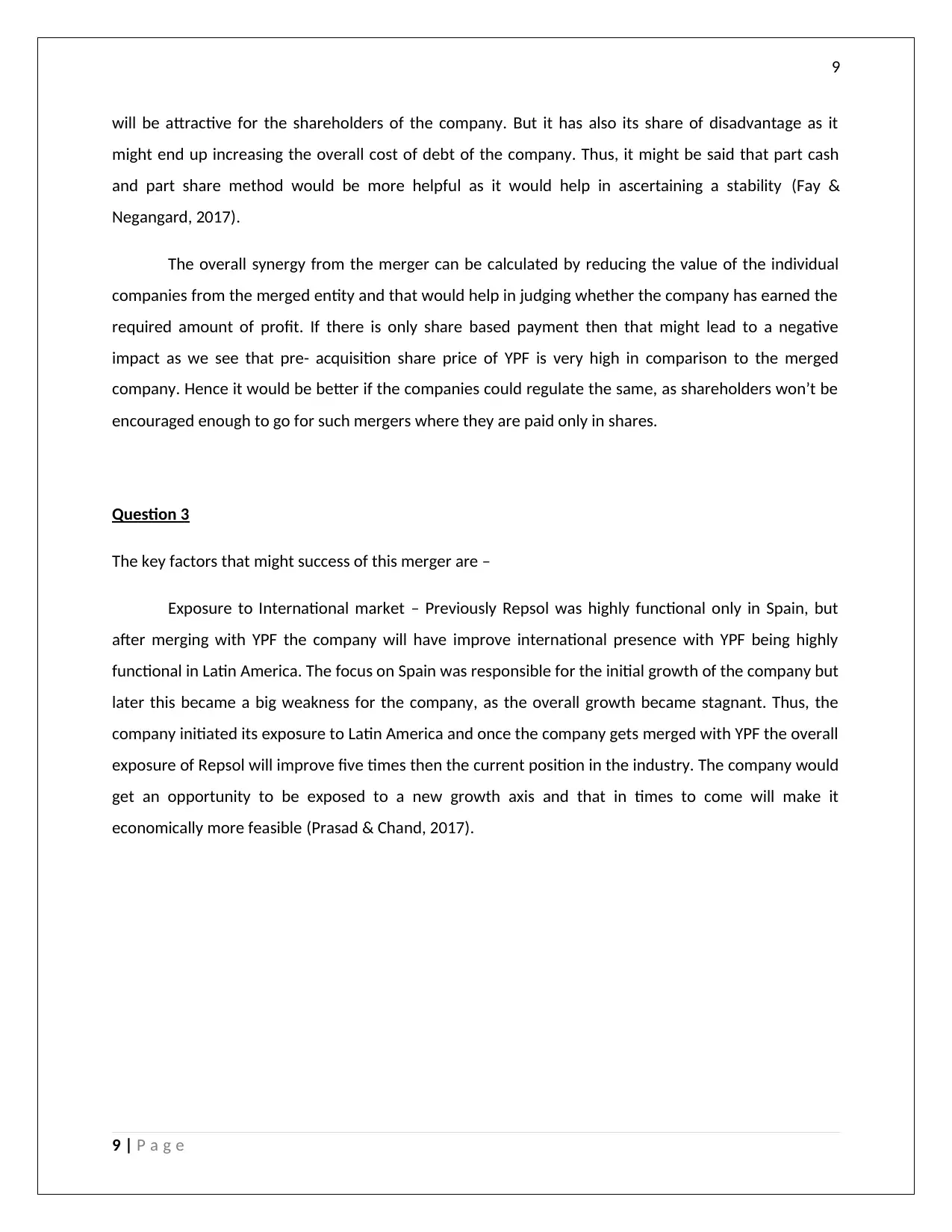
9
will be attractive for the shareholders of the company. But it has also its share of disadvantage as it
might end up increasing the overall cost of debt of the company. Thus, it might be said that part cash
and part share method would be more helpful as it would help in ascertaining a stability (Fay &
Negangard, 2017).
The overall synergy from the merger can be calculated by reducing the value of the individual
companies from the merged entity and that would help in judging whether the company has earned the
required amount of profit. If there is only share based payment then that might lead to a negative
impact as we see that pre- acquisition share price of YPF is very high in comparison to the merged
company. Hence it would be better if the companies could regulate the same, as shareholders won’t be
encouraged enough to go for such mergers where they are paid only in shares.
Question 3
The key factors that might success of this merger are –
Exposure to International market – Previously Repsol was highly functional only in Spain, but
after merging with YPF the company will have improve international presence with YPF being highly
functional in Latin America. The focus on Spain was responsible for the initial growth of the company but
later this became a big weakness for the company, as the overall growth became stagnant. Thus, the
company initiated its exposure to Latin America and once the company gets merged with YPF the overall
exposure of Repsol will improve five times then the current position in the industry. The company would
get an opportunity to be exposed to a new growth axis and that in times to come will make it
economically more feasible (Prasad & Chand, 2017).
9 | P a g e
will be attractive for the shareholders of the company. But it has also its share of disadvantage as it
might end up increasing the overall cost of debt of the company. Thus, it might be said that part cash
and part share method would be more helpful as it would help in ascertaining a stability (Fay &
Negangard, 2017).
The overall synergy from the merger can be calculated by reducing the value of the individual
companies from the merged entity and that would help in judging whether the company has earned the
required amount of profit. If there is only share based payment then that might lead to a negative
impact as we see that pre- acquisition share price of YPF is very high in comparison to the merged
company. Hence it would be better if the companies could regulate the same, as shareholders won’t be
encouraged enough to go for such mergers where they are paid only in shares.
Question 3
The key factors that might success of this merger are –
Exposure to International market – Previously Repsol was highly functional only in Spain, but
after merging with YPF the company will have improve international presence with YPF being highly
functional in Latin America. The focus on Spain was responsible for the initial growth of the company but
later this became a big weakness for the company, as the overall growth became stagnant. Thus, the
company initiated its exposure to Latin America and once the company gets merged with YPF the overall
exposure of Repsol will improve five times then the current position in the industry. The company would
get an opportunity to be exposed to a new growth axis and that in times to come will make it
economically more feasible (Prasad & Chand, 2017).
9 | P a g e
Paraphrase This Document
Need a fresh take? Get an instant paraphrase of this document with our AI Paraphraser
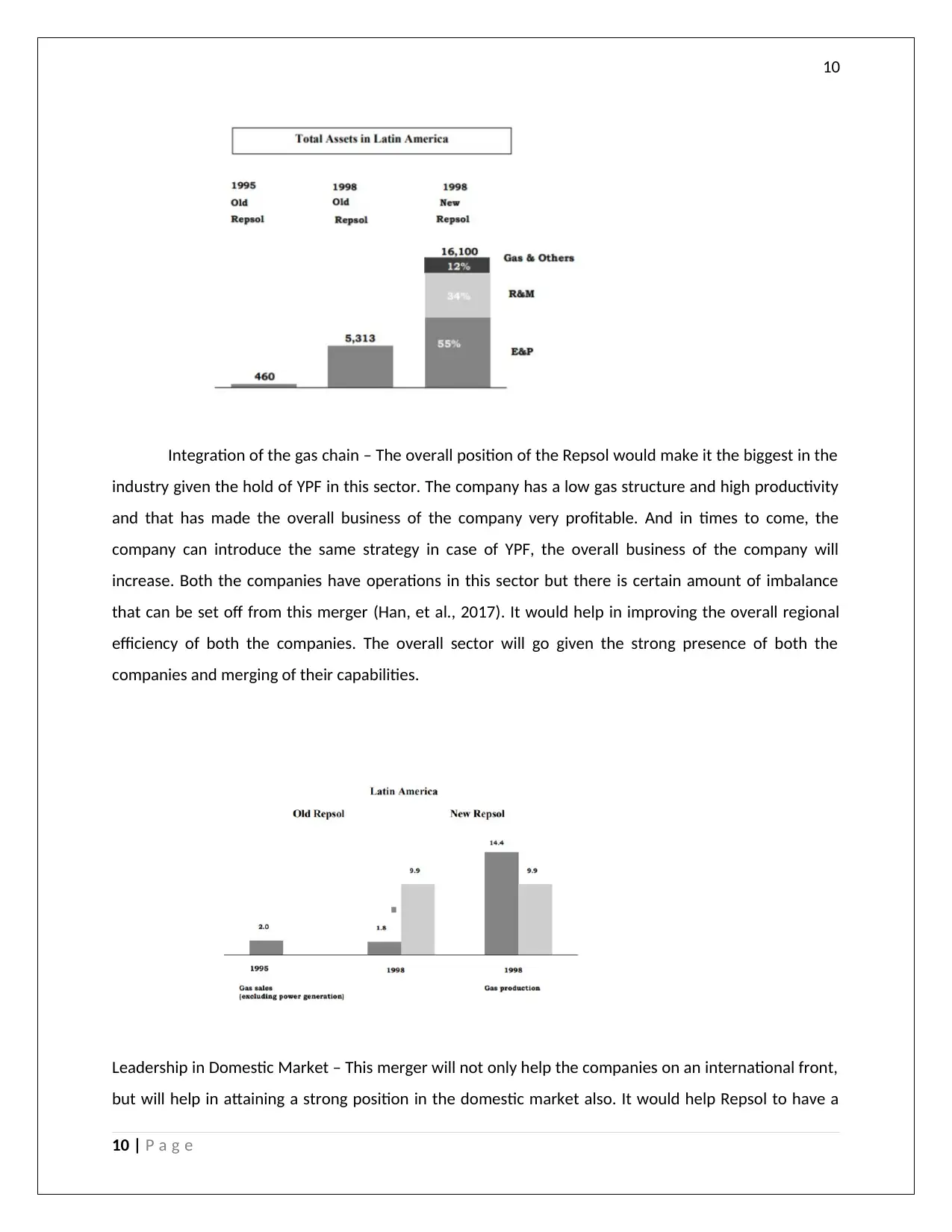
10
Integration of the gas chain – The overall position of the Repsol would make it the biggest in the
industry given the hold of YPF in this sector. The company has a low gas structure and high productivity
and that has made the overall business of the company very profitable. And in times to come, the
company can introduce the same strategy in case of YPF, the overall business of the company will
increase. Both the companies have operations in this sector but there is certain amount of imbalance
that can be set off from this merger (Han, et al., 2017). It would help in improving the overall regional
efficiency of both the companies. The overall sector will go given the strong presence of both the
companies and merging of their capabilities.
Leadership in Domestic Market – This merger will not only help the companies on an international front,
but will help in attaining a strong position in the domestic market also. It would help Repsol to have a
10 | P a g e
Integration of the gas chain – The overall position of the Repsol would make it the biggest in the
industry given the hold of YPF in this sector. The company has a low gas structure and high productivity
and that has made the overall business of the company very profitable. And in times to come, the
company can introduce the same strategy in case of YPF, the overall business of the company will
increase. Both the companies have operations in this sector but there is certain amount of imbalance
that can be set off from this merger (Han, et al., 2017). It would help in improving the overall regional
efficiency of both the companies. The overall sector will go given the strong presence of both the
companies and merging of their capabilities.
Leadership in Domestic Market – This merger will not only help the companies on an international front,
but will help in attaining a strong position in the domestic market also. It would help Repsol to have a
10 | P a g e
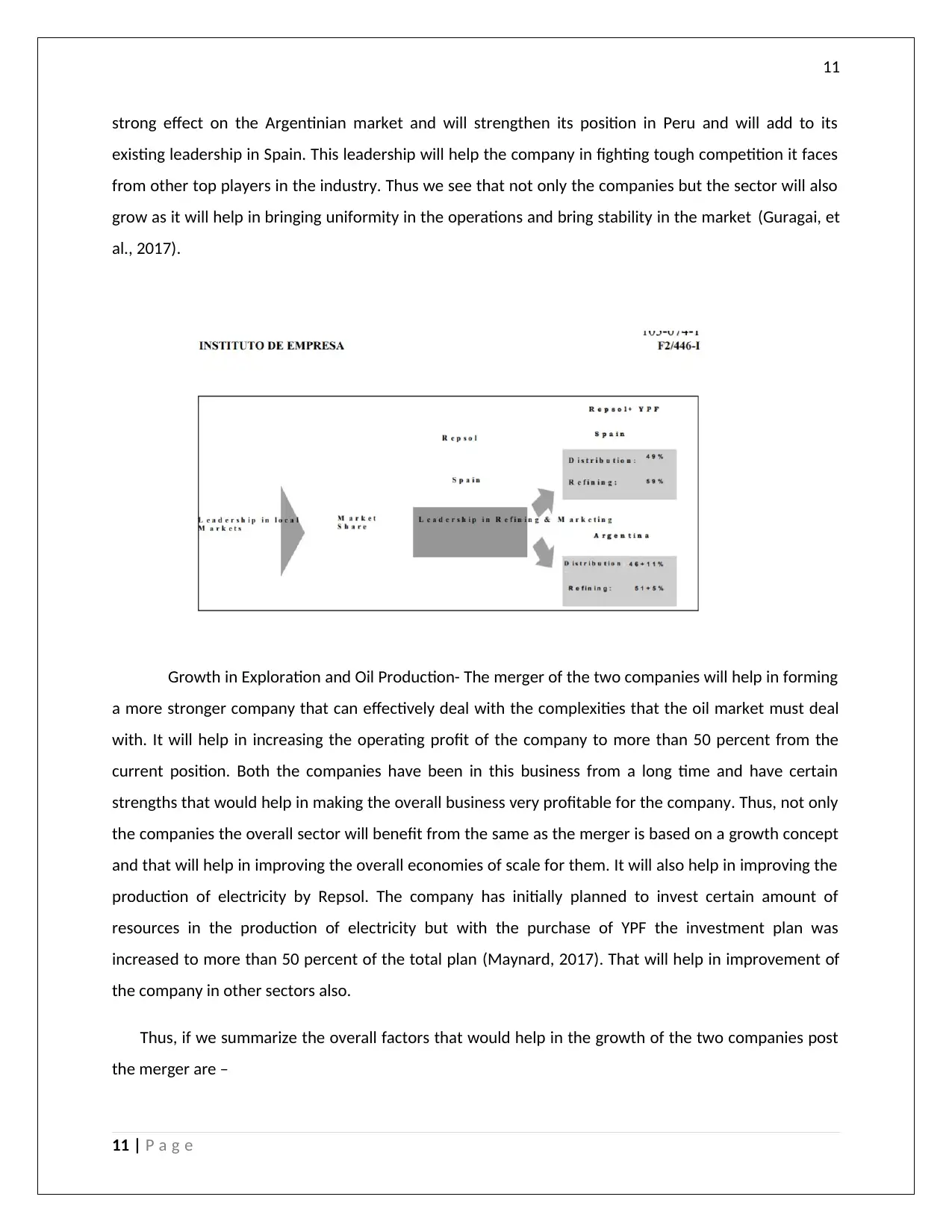
11
strong effect on the Argentinian market and will strengthen its position in Peru and will add to its
existing leadership in Spain. This leadership will help the company in fighting tough competition it faces
from other top players in the industry. Thus we see that not only the companies but the sector will also
grow as it will help in bringing uniformity in the operations and bring stability in the market (Guragai, et
al., 2017).
Growth in Exploration and Oil Production- The merger of the two companies will help in forming
a more stronger company that can effectively deal with the complexities that the oil market must deal
with. It will help in increasing the operating profit of the company to more than 50 percent from the
current position. Both the companies have been in this business from a long time and have certain
strengths that would help in making the overall business very profitable for the company. Thus, not only
the companies the overall sector will benefit from the same as the merger is based on a growth concept
and that will help in improving the overall economies of scale for them. It will also help in improving the
production of electricity by Repsol. The company has initially planned to invest certain amount of
resources in the production of electricity but with the purchase of YPF the investment plan was
increased to more than 50 percent of the total plan (Maynard, 2017). That will help in improvement of
the company in other sectors also.
Thus, if we summarize the overall factors that would help in the growth of the two companies post
the merger are –
11 | P a g e
strong effect on the Argentinian market and will strengthen its position in Peru and will add to its
existing leadership in Spain. This leadership will help the company in fighting tough competition it faces
from other top players in the industry. Thus we see that not only the companies but the sector will also
grow as it will help in bringing uniformity in the operations and bring stability in the market (Guragai, et
al., 2017).
Growth in Exploration and Oil Production- The merger of the two companies will help in forming
a more stronger company that can effectively deal with the complexities that the oil market must deal
with. It will help in increasing the operating profit of the company to more than 50 percent from the
current position. Both the companies have been in this business from a long time and have certain
strengths that would help in making the overall business very profitable for the company. Thus, not only
the companies the overall sector will benefit from the same as the merger is based on a growth concept
and that will help in improving the overall economies of scale for them. It will also help in improving the
production of electricity by Repsol. The company has initially planned to invest certain amount of
resources in the production of electricity but with the purchase of YPF the investment plan was
increased to more than 50 percent of the total plan (Maynard, 2017). That will help in improvement of
the company in other sectors also.
Thus, if we summarize the overall factors that would help in the growth of the two companies post
the merger are –
11 | P a g e
You're viewing a preview
Unlock full access by subscribing today!
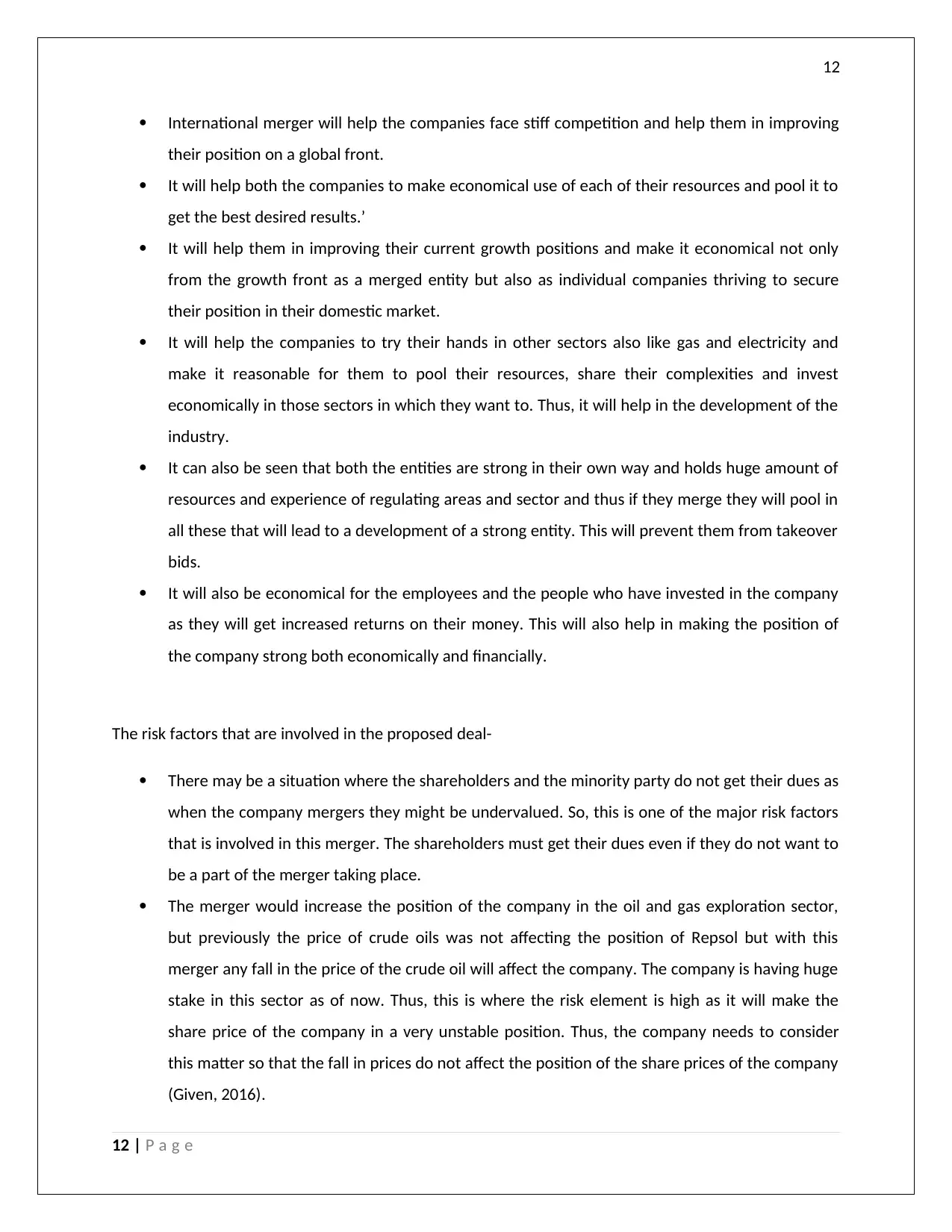
12
International merger will help the companies face stiff competition and help them in improving
their position on a global front.
It will help both the companies to make economical use of each of their resources and pool it to
get the best desired results.’
It will help them in improving their current growth positions and make it economical not only
from the growth front as a merged entity but also as individual companies thriving to secure
their position in their domestic market.
It will help the companies to try their hands in other sectors also like gas and electricity and
make it reasonable for them to pool their resources, share their complexities and invest
economically in those sectors in which they want to. Thus, it will help in the development of the
industry.
It can also be seen that both the entities are strong in their own way and holds huge amount of
resources and experience of regulating areas and sector and thus if they merge they will pool in
all these that will lead to a development of a strong entity. This will prevent them from takeover
bids.
It will also be economical for the employees and the people who have invested in the company
as they will get increased returns on their money. This will also help in making the position of
the company strong both economically and financially.
The risk factors that are involved in the proposed deal-
There may be a situation where the shareholders and the minority party do not get their dues as
when the company mergers they might be undervalued. So, this is one of the major risk factors
that is involved in this merger. The shareholders must get their dues even if they do not want to
be a part of the merger taking place.
The merger would increase the position of the company in the oil and gas exploration sector,
but previously the price of crude oils was not affecting the position of Repsol but with this
merger any fall in the price of the crude oil will affect the company. The company is having huge
stake in this sector as of now. Thus, this is where the risk element is high as it will make the
share price of the company in a very unstable position. Thus, the company needs to consider
this matter so that the fall in prices do not affect the position of the share prices of the company
(Given, 2016).
12 | P a g e
International merger will help the companies face stiff competition and help them in improving
their position on a global front.
It will help both the companies to make economical use of each of their resources and pool it to
get the best desired results.’
It will help them in improving their current growth positions and make it economical not only
from the growth front as a merged entity but also as individual companies thriving to secure
their position in their domestic market.
It will help the companies to try their hands in other sectors also like gas and electricity and
make it reasonable for them to pool their resources, share their complexities and invest
economically in those sectors in which they want to. Thus, it will help in the development of the
industry.
It can also be seen that both the entities are strong in their own way and holds huge amount of
resources and experience of regulating areas and sector and thus if they merge they will pool in
all these that will lead to a development of a strong entity. This will prevent them from takeover
bids.
It will also be economical for the employees and the people who have invested in the company
as they will get increased returns on their money. This will also help in making the position of
the company strong both economically and financially.
The risk factors that are involved in the proposed deal-
There may be a situation where the shareholders and the minority party do not get their dues as
when the company mergers they might be undervalued. So, this is one of the major risk factors
that is involved in this merger. The shareholders must get their dues even if they do not want to
be a part of the merger taking place.
The merger would increase the position of the company in the oil and gas exploration sector,
but previously the price of crude oils was not affecting the position of Repsol but with this
merger any fall in the price of the crude oil will affect the company. The company is having huge
stake in this sector as of now. Thus, this is where the risk element is high as it will make the
share price of the company in a very unstable position. Thus, the company needs to consider
this matter so that the fall in prices do not affect the position of the share prices of the company
(Given, 2016).
12 | P a g e
Paraphrase This Document
Need a fresh take? Get an instant paraphrase of this document with our AI Paraphraser
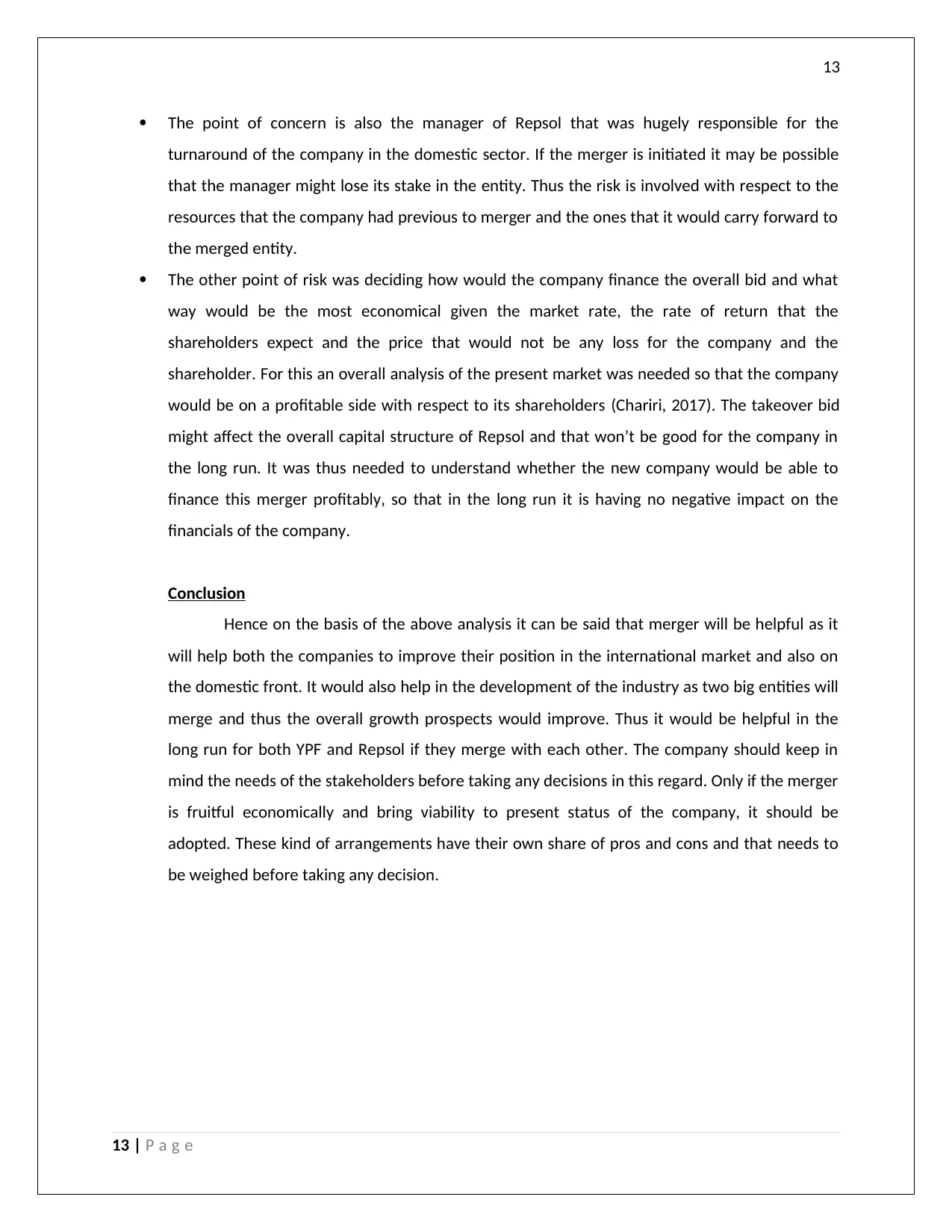
13
The point of concern is also the manager of Repsol that was hugely responsible for the
turnaround of the company in the domestic sector. If the merger is initiated it may be possible
that the manager might lose its stake in the entity. Thus the risk is involved with respect to the
resources that the company had previous to merger and the ones that it would carry forward to
the merged entity.
The other point of risk was deciding how would the company finance the overall bid and what
way would be the most economical given the market rate, the rate of return that the
shareholders expect and the price that would not be any loss for the company and the
shareholder. For this an overall analysis of the present market was needed so that the company
would be on a profitable side with respect to its shareholders (Chariri, 2017). The takeover bid
might affect the overall capital structure of Repsol and that won’t be good for the company in
the long run. It was thus needed to understand whether the new company would be able to
finance this merger profitably, so that in the long run it is having no negative impact on the
financials of the company.
Conclusion
Hence on the basis of the above analysis it can be said that merger will be helpful as it
will help both the companies to improve their position in the international market and also on
the domestic front. It would also help in the development of the industry as two big entities will
merge and thus the overall growth prospects would improve. Thus it would be helpful in the
long run for both YPF and Repsol if they merge with each other. The company should keep in
mind the needs of the stakeholders before taking any decisions in this regard. Only if the merger
is fruitful economically and bring viability to present status of the company, it should be
adopted. These kind of arrangements have their own share of pros and cons and that needs to
be weighed before taking any decision.
13 | P a g e
The point of concern is also the manager of Repsol that was hugely responsible for the
turnaround of the company in the domestic sector. If the merger is initiated it may be possible
that the manager might lose its stake in the entity. Thus the risk is involved with respect to the
resources that the company had previous to merger and the ones that it would carry forward to
the merged entity.
The other point of risk was deciding how would the company finance the overall bid and what
way would be the most economical given the market rate, the rate of return that the
shareholders expect and the price that would not be any loss for the company and the
shareholder. For this an overall analysis of the present market was needed so that the company
would be on a profitable side with respect to its shareholders (Chariri, 2017). The takeover bid
might affect the overall capital structure of Repsol and that won’t be good for the company in
the long run. It was thus needed to understand whether the new company would be able to
finance this merger profitably, so that in the long run it is having no negative impact on the
financials of the company.
Conclusion
Hence on the basis of the above analysis it can be said that merger will be helpful as it
will help both the companies to improve their position in the international market and also on
the domestic front. It would also help in the development of the industry as two big entities will
merge and thus the overall growth prospects would improve. Thus it would be helpful in the
long run for both YPF and Repsol if they merge with each other. The company should keep in
mind the needs of the stakeholders before taking any decisions in this regard. Only if the merger
is fruitful economically and bring viability to present status of the company, it should be
adopted. These kind of arrangements have their own share of pros and cons and that needs to
be weighed before taking any decision.
13 | P a g e
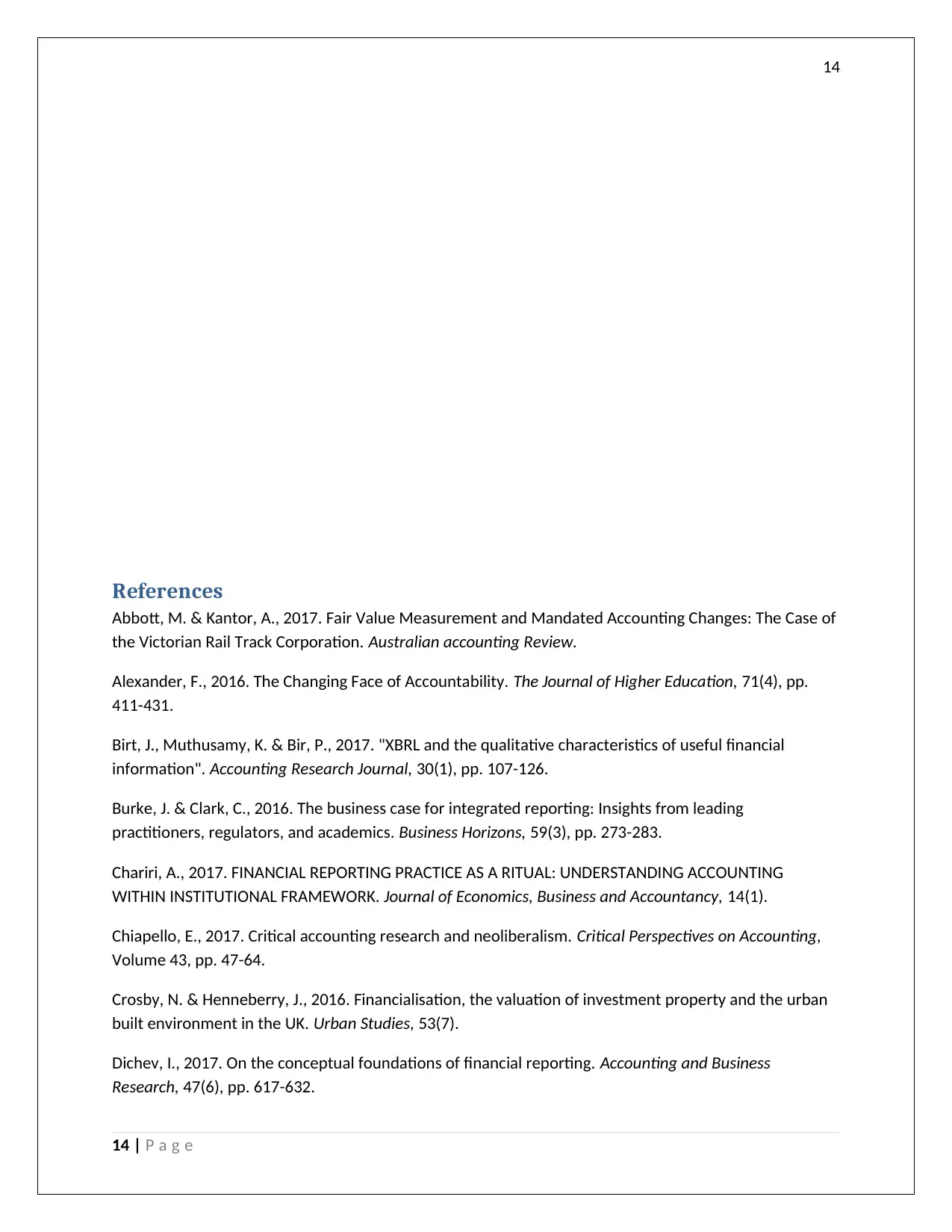
14
References
Abbott, M. & Kantor, A., 2017. Fair Value Measurement and Mandated Accounting Changes: The Case of
the Victorian Rail Track Corporation. Australian accounting Review.
Alexander, F., 2016. The Changing Face of Accountability. The Journal of Higher Education, 71(4), pp.
411-431.
Birt, J., Muthusamy, K. & Bir, P., 2017. "XBRL and the qualitative characteristics of useful financial
information". Accounting Research Journal, 30(1), pp. 107-126.
Burke, J. & Clark, C., 2016. The business case for integrated reporting: Insights from leading
practitioners, regulators, and academics. Business Horizons, 59(3), pp. 273-283.
Chariri, A., 2017. FINANCIAL REPORTING PRACTICE AS A RITUAL: UNDERSTANDING ACCOUNTING
WITHIN INSTITUTIONAL FRAMEWORK. Journal of Economics, Business and Accountancy, 14(1).
Chiapello, E., 2017. Critical accounting research and neoliberalism. Critical Perspectives on Accounting,
Volume 43, pp. 47-64.
Crosby, N. & Henneberry, J., 2016. Financialisation, the valuation of investment property and the urban
built environment in the UK. Urban Studies, 53(7).
Dichev, I., 2017. On the conceptual foundations of financial reporting. Accounting and Business
Research, 47(6), pp. 617-632.
14 | P a g e
References
Abbott, M. & Kantor, A., 2017. Fair Value Measurement and Mandated Accounting Changes: The Case of
the Victorian Rail Track Corporation. Australian accounting Review.
Alexander, F., 2016. The Changing Face of Accountability. The Journal of Higher Education, 71(4), pp.
411-431.
Birt, J., Muthusamy, K. & Bir, P., 2017. "XBRL and the qualitative characteristics of useful financial
information". Accounting Research Journal, 30(1), pp. 107-126.
Burke, J. & Clark, C., 2016. The business case for integrated reporting: Insights from leading
practitioners, regulators, and academics. Business Horizons, 59(3), pp. 273-283.
Chariri, A., 2017. FINANCIAL REPORTING PRACTICE AS A RITUAL: UNDERSTANDING ACCOUNTING
WITHIN INSTITUTIONAL FRAMEWORK. Journal of Economics, Business and Accountancy, 14(1).
Chiapello, E., 2017. Critical accounting research and neoliberalism. Critical Perspectives on Accounting,
Volume 43, pp. 47-64.
Crosby, N. & Henneberry, J., 2016. Financialisation, the valuation of investment property and the urban
built environment in the UK. Urban Studies, 53(7).
Dichev, I., 2017. On the conceptual foundations of financial reporting. Accounting and Business
Research, 47(6), pp. 617-632.
14 | P a g e
You're viewing a preview
Unlock full access by subscribing today!
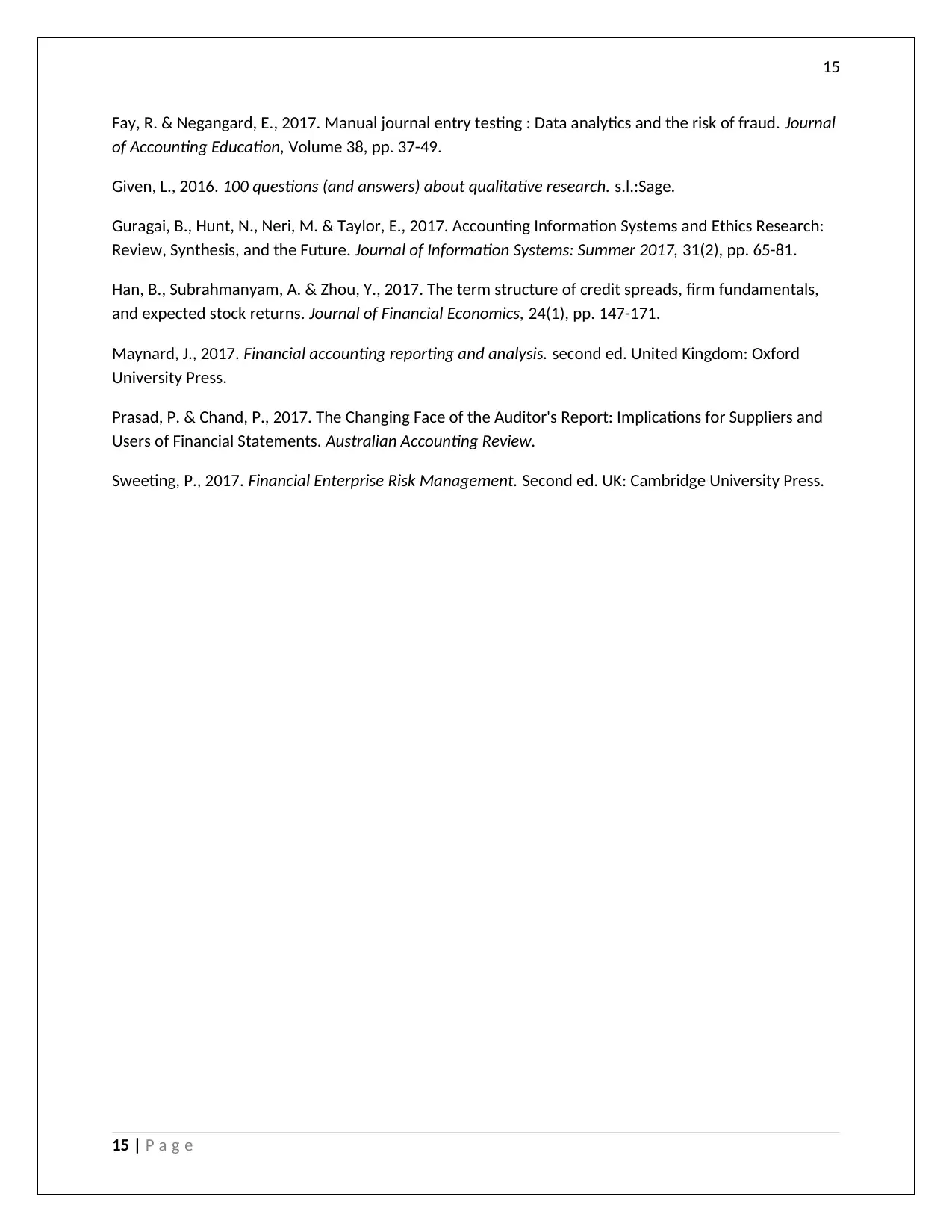
15
Fay, R. & Negangard, E., 2017. Manual journal entry testing : Data analytics and the risk of fraud. Journal
of Accounting Education, Volume 38, pp. 37-49.
Given, L., 2016. 100 questions (and answers) about qualitative research. s.l.:Sage.
Guragai, B., Hunt, N., Neri, M. & Taylor, E., 2017. Accounting Information Systems and Ethics Research:
Review, Synthesis, and the Future. Journal of Information Systems: Summer 2017, 31(2), pp. 65-81.
Han, B., Subrahmanyam, A. & Zhou, Y., 2017. The term structure of credit spreads, firm fundamentals,
and expected stock returns. Journal of Financial Economics, 24(1), pp. 147-171.
Maynard, J., 2017. Financial accounting reporting and analysis. second ed. United Kingdom: Oxford
University Press.
Prasad, P. & Chand, P., 2017. The Changing Face of the Auditor's Report: Implications for Suppliers and
Users of Financial Statements. Australian Accounting Review.
Sweeting, P., 2017. Financial Enterprise Risk Management. Second ed. UK: Cambridge University Press.
15 | P a g e
Fay, R. & Negangard, E., 2017. Manual journal entry testing : Data analytics and the risk of fraud. Journal
of Accounting Education, Volume 38, pp. 37-49.
Given, L., 2016. 100 questions (and answers) about qualitative research. s.l.:Sage.
Guragai, B., Hunt, N., Neri, M. & Taylor, E., 2017. Accounting Information Systems and Ethics Research:
Review, Synthesis, and the Future. Journal of Information Systems: Summer 2017, 31(2), pp. 65-81.
Han, B., Subrahmanyam, A. & Zhou, Y., 2017. The term structure of credit spreads, firm fundamentals,
and expected stock returns. Journal of Financial Economics, 24(1), pp. 147-171.
Maynard, J., 2017. Financial accounting reporting and analysis. second ed. United Kingdom: Oxford
University Press.
Prasad, P. & Chand, P., 2017. The Changing Face of the Auditor's Report: Implications for Suppliers and
Users of Financial Statements. Australian Accounting Review.
Sweeting, P., 2017. Financial Enterprise Risk Management. Second ed. UK: Cambridge University Press.
15 | P a g e
1 out of 16
Your All-in-One AI-Powered Toolkit for Academic Success.
+13062052269
info@desklib.com
Available 24*7 on WhatsApp / Email
![[object Object]](/_next/static/media/star-bottom.7253800d.svg)
Unlock your academic potential
© 2024 | Zucol Services PVT LTD | All rights reserved.

